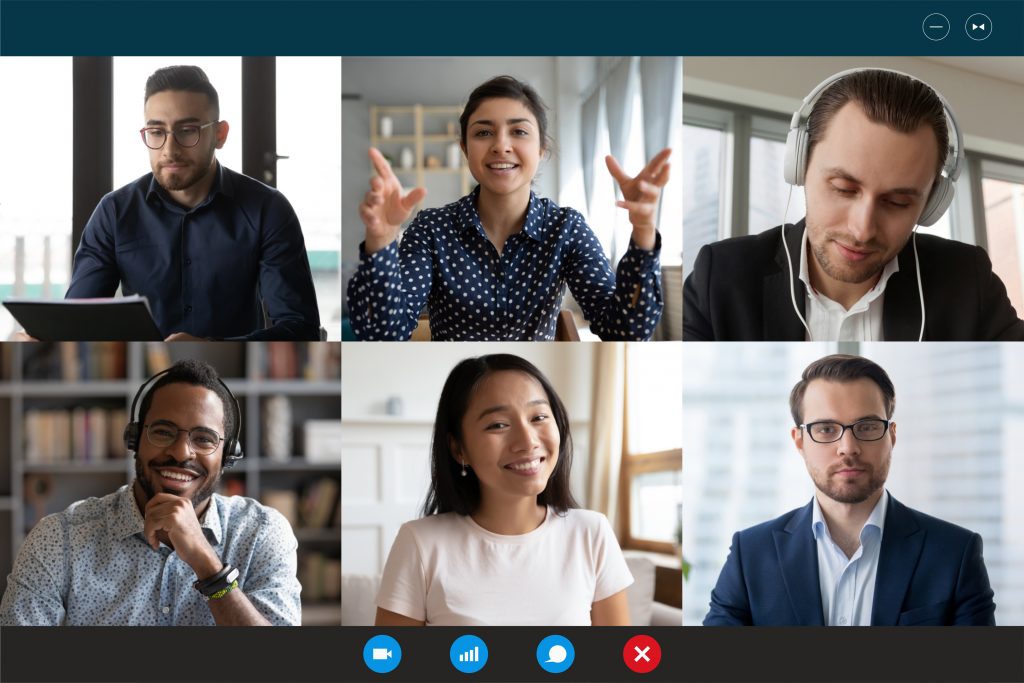
The first time I saw someone outside of my household following the easing of lockdown restrictions, I was blown away to see that they consisted of more than just a head and shoulders.
That’s all we really see of anyone nowadays! How was I supposed to know?
OK, I am displaying massively exaggerated ignorance here, however it is pretty clear to us all that the past year has not really been the era of mass social interaction, has it? Especially not in-person interaction.
And… if the future is anything like everyone seems to be predicting it will be, then we are not experiencing the beginning of the end of the social impact of COVID-19. We are at the end of the beginning.
The above sounds like an incredibly upsetting way of viewing things, however I do not mean it in the gloomy way that it may initially seem.
What I mean is that the drastic communicative overhaul enforced by the pandemic is not just going to vanish with the production and distribution of a vaccine.
It will take time. Especially in a professional setting.
Are we going to see people travel hundreds of miles to visit others in a professional capacity in the near future? Yes, of course.
In the same numbers that we saw in the years preceding 2020 though? It is highly unlikely.
Therefore, me telling you that understanding the Social Styles Model is like possessing a superpower during this time may seem an extremely bizarre statement to make.
Our social lives have changed, so has the Social Styles Model?
Well, the model has not changed, the fundamentals are all the same. However, thanks to the changes in the world over the past year, the way we interact for the most part, is completely different. Therefore, we are applying different data to the same model.
If you are new to the Social Styles Model, then here is a little overview for you…
The model uses behavioural traits and patterns of interaction to categorise people into one of four social styles. The four styles being Analytical, Driving, Amiable and Expressive.
Not only is this model a fantastic way to gain self-awareness around your own style and social preferences, but it is also a key way of identifying how to effectively interact with everyone you have the pleasure to meet, as you will have the knowledge to identify their style and then to be able to flex your own.
It enables you to build rapport and productive relationships, giving you a huge edge over someone completely unaware of different social styles and just hoping that others do the flexing for them.
There are many ways in which you can make a judgement as to what a person’s social style is. Some of which are subconscious.
When in person, these can take place before even engaging in conversation, such as how the person is dressed, their body language and posture.
These judgements do not always prove to be accurate, as once you are exposed to more data, you then become capable of making a clearer decision on their style. However, they are a pretty good indicator of how you may look to initially engage in conversation with this person. An educated guess.
With video chats and virtual meetings replacing much of our face-to-face encounters, these educated guesses have now become… well, less educated.
The clues you may pick up pre-conversation are pretty much eradicated due to the nature of these meetings in comparison to an in-person environment. You press a button and you are immediately speaking screen to screen.
Of course, you can still seek to pick this information up during a video call, however it may not guide you towards as accurate an answer as previously.
Seeking style clues from how someone is dressed is now for the most part, restricted to their shoulders up (they may only be business from the waist up). Same restrictions apply for body language. Therefore, we are really missing the clarity we once had.
This means that it is key to be wary of the clues you do receive from the early stages of video interactions, as it can be easy to make style assumptions based solely on these.

Try this one on for size.
Let’s say for instance, you are meeting a new client and they join your video meeting. To your shock, once they join, their virtual background is of a nightclub dancefloor and they have a filter on which gives them cat features. Whiskers, ears, the lot.
What assumptions could you immediately make about this person at that moment?
You may think that they are an expressive, who is just showing off their fun-loving side to you?
Potentially yes.
However, it also could be that they have a child who used their account before them with their friends and decided to become a feline. Whilst this is still your first impression of this person you are meeting; it may tell you more about other aspects of them rather than their social style.
Immediately trusting this as information about their style could mean that you approach your conversation in a way that is not as effective as it would be for their actual social style.
Of course, you can still misjudge something in person, however the signs of their true style is likely to shine through much clearer than virtually, making it quicker to amend an inaccurate assessment.
Another style trap virtual meetings can catch us in is the other person’s environment.
Like an episode of ‘Through the Keyhole’, video calls have given us a glimpse into people’s households… the hub of their private lives.
If you are not a virtual background user, what you present behind you during a call could again present itself as another potential clue towards the type of person you are.
Let’s play this game again…
Your client has joined a video call and behind them, you cannot help but notice the messy unmade bed with worn clothes strewn from pillow to bedpost. It makes you wonder about what else exists beyond this snapshot in the background, and also, why this person chose to sit Infront of a laundry apocalypse for your meeting.
What could be an assumption you make about this person’s style?
It could be assumed that the messy unmade bed may not be the background of choice for a person with an analytical social style, who is renown to strive for perfection.
This again in terms of data for us to judge social styles is not the most reliable.
By using these visuals as information, we again risk basing our judgement on something that actually has nothing to do with the person themselves. They may live with people who that background reflects more than themselves. Additionally, we see a tiny amount of a very big space, so forming judgements off this person’s backdrop may not get you the most accurate of answers on their social preference.
These are just a couple of examples of judgements that we need to be wary of when trying to calculate someone’s style virtually. We have to remember that this isn’t us seeing it for ourselves in person, and that there are many more factors involved here which could complicate how you determine a social style.

So, what can we do to make this simpler?
Whilst visual clues may be a sign of a social style, I would suggest not committing solidly to your initial judgements virtually as you might in person, and wait for further audible confirmation.
This includes:
– How the topic of conversation evolves. How often they stick to the topic at hand.
– The energy they speak with, including pace and tone.
– Are they using words that express emotion or logic. (Think vs feel)
This will either confirm your initial judgements were correct about the person’s style, or it will save you from heading tunnel-visioned into a conversation based on new misleading visual information, and not building the type of relationship you desire or not achieving your outcomes for that discussion.
It may feel unnatural to not place as much trust in your initial observations, however by waiting for information which is more trustworthy when communicating virtually, you are giving yourself a much better chance to make a greater amount of valuable connections.
Thanks
Alex & The Excel Team
P.S. If you would like to discuss any of your learning & development challenges for 2021, call us on +44(0) 1628488 854.

About Excel Communications
Excel Communications is a learning and development consultancy based near London in the U.K. For more than 30 years; we have been collaborating with clients across the globe.
Partnering with Excel empowers you to evolve your people and business by fuelling a love for learning.
We work with you to create unforgettably, customised learning experiences to achieve your vision of success and growth, with tangible results.
View our case studies here.
We have a team of expert trainers delivering programmes across five continents in multiple languages. Call us now on +44 (0) 1628 488 854.
